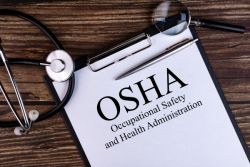OSHA Requirements
It is necessary to implement work practice and engineering controls to help prevent exposure to sharps.
OSHA requires sharps must be appropriately disposed of immediately or as soon as feasible into the appropriate containers. 29 CFR 1910.1030(d)(4)(iii)(A)(1)
Handling Sharps Containers
- Contaminated sharps must be appropriately disposed of immediately or as soon as feasible in containers that are closable, puncture-resistant, leak-proof, and labeled with the biohazard symbol or color-coded per 29 CFR 1910.1030(d)(4)(iii)(A)(1) , 29 CFR 1910.1030(g)(1)(i)
- Containers must be replaced routinely and not be allowed to overfill. 29 CFR 1910.1030(d)(4)(iii)(A)(2)
Disposal of Sharps Containers
Employees should be trained how to properly handle and dispose of sharps and containers. Containers should be:
- Closed immediately before removal or replacement to prevent spillage or protrusion of contents during handling, storage, transport, or shipping.
- Placed in a secondary container, if leakage is possible. The secondary container must meet the requirements of 29 CFR 1910.1030(d)(4)(A)(3)(ii) .
- Disposed of in accordance with EPA, state, territorial, and local regulations per 29 CFR 1910.1030(d)(4)(iii)(C) .
Resuable Sharps Containers
- Reusable sharps containers must not be opened, emptied, or cleaned manually or in any other manner that could expose employees to the risk of percutaneous injury.
- Employers must maintain a log of injuries from contaminated sharps. 29 CFR 1910.1030(h)(5)(i) .
Knowledge Check Choose the best answer for the question.
1-5. When should sharps be appropriately disposed of into the appropriate containers?
You forgot to answer the question!

